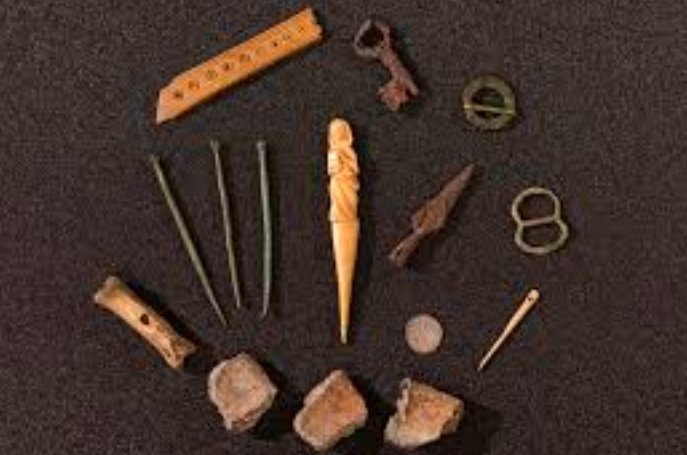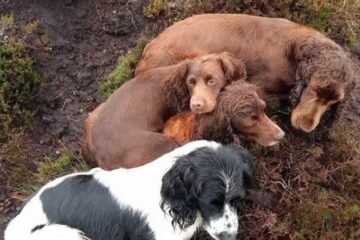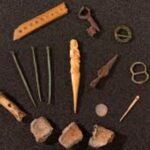Archaeologists unearthed a rare 13th century hair styling tool at Eilean Donan Castle in the Scottish Highlands during recent excavations. This gravoir, carved from red deer antler, offers a glimpse into medieval daily life and has been acquired by National Museums Scotland as part of a larger collection of artifacts.
The Unique Discovery of the Gravoir
The gravoir stands out for its detailed design. It features a small hooded figure holding a book, making it not just functional but also artistic. Experts note that such tools originated in France and spread across Europe in the 1300s, helping people create precise parts and elaborate hairstyles popular among the elite.
This find marks the first gravoir ever discovered in Scotland. Only two others exist in the entire United Kingdom, both from sites in London. The tool’s use of local red deer antler highlights how castle residents adapted continental trends with materials at hand. Dr. Alice Blackwell, a senior curator at National Museums Scotland, described it as an incredibly rare object that connects Scotland to broader European fashions.
The excavations, led by FAS Heritage and commissioned by the museum, took place in the castle’s northwest tower. They aimed to uncover more about the site’s medieval past, a time when little was known beyond its role as a defensive stronghold.

A Glimpse into Eilean Donan Castle’s Rich History
Eilean Donan Castle sits on a small island where three lochs meet in northern Scotland. Builders raised it in the early 1200s to guard against Viking raids and later served as a key Gaelic lordship center through the 1400s. Over centuries, it faced destruction, including a major blow in 1719 during conflicts with Jacobite forces.
The castle lay in ruins for nearly 200 years until a British officer bought it in 1911. He rebuilt it using old records, turning it into the iconic structure visitors see today. This romantic fortress has starred in films like Highlander and James Bond’s The World Is Not Enough, drawing crowds from around the globe.
Recent digs reveal that life inside went far beyond battles. The site buzzed with activity, from crafting jewelry to hosting feasts. Traces of precious metals in the soil suggest on site metalworking, producing items like buckles and even swords. This collection now forms one of Britain’s most important medieval metalwork assemblages.
What the Gravoir Tells Us About Medieval Grooming
In medieval times, hair styling served as a status symbol. Nobles and high ranking residents used tools like the gravoir to achieve neat parts and complex looks inspired by French court styles. Blackwell explained that it likely paired with a comb and mirror in a personal grooming set.
The antler material points to resourcefulness. While most known gravoirs come from ivory, this local choice shows how Scots blended luxury with practicality. Such artifacts challenge old views of isolated Highland life, proving connections to wider Europe.
Experts believe the tool belonged to an elite inhabitant. Its presence suggests that even in a remote fortress, people cared about appearance amid daily duties. This find adds emotional depth, letting us picture a resident carefully styling hair before a feast or meeting.
Other Artifacts Unearth Daily Life at the Castle
The gravoir joins hundreds of items in the new collection, stored in about 80 boxes at the National Museums Collection Centre in Edinburgh. These objects paint a full picture of castle routines across social classes.
Here are some key finds from the excavations:
- Brooches and dress pins, showing fashion and personal adornment.
- Gaming pieces carved from bone, hinting at leisure time for residents.
- An iron jaw harp, a musical instrument for entertainment during gatherings.
- Recycled pottery shards, evidence of everyday eating and storage.
- Simple toys, suggesting children played within the walls.
These items reveal a vibrant community. Smiths worked metal, cooks prepared meals, and families enjoyed simple joys. The assortment helps researchers study everything from trade links to childhood in medieval Scotland.
To organize the broader impact, consider this table of artifact categories and their insights:
| Artifact Category | Examples | Insights into Medieval Life |
|---|---|---|
| Grooming Tools | Gravoir, possible combs | Elite fashions and personal care routines |
| Metalwork Items | Brooches, buckles, sword parts | On site crafting and economic activity |
| Leisure Objects | Gaming pieces, jaw harp | Social interactions and downtime |
| Household Goods | Pottery, toys | Daily domestic tasks and family dynamics |
| Feasting Gear | Drinking vessels | Communal events and hospitality |
This table underscores the diverse roles people played, from artisans to entertainers.
Why This Find Matters for Scottish Heritage
The acquisition by National Museums Scotland ensures these treasures stay in the country for study and display. It builds on recent efforts to explore Scotland’s past, like digs at other sites such as Stirling Castle, where similar medieval items have surfaced. These projects highlight a growing interest in everyday history, not just kings and wars.
The discovery boosts tourism too. Eilean Donan already attracts thousands yearly for its stunning views. Now, visitors can connect more deeply with its human story. As Blackwell noted, the artifacts let us imagine the full range of lives inside, from hair styling to toy making.
This rare find reminds us that history hides in small details. It solves puzzles about how medieval Scots lived and entertained, while sparking curiosity about forgotten customs. For anyone fascinated by the past, it proves that even a simple tool can rewrite what we know.
Share your thoughts on this exciting discovery in the comments below. What other medieval secrets do you hope archaeologists uncover next?


















